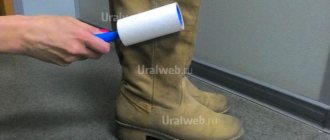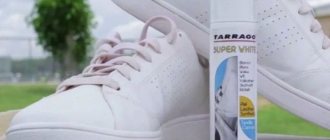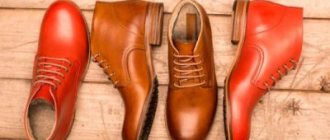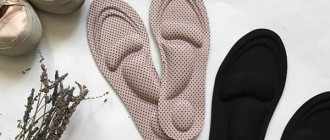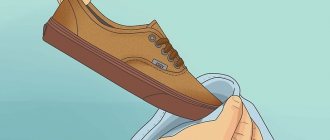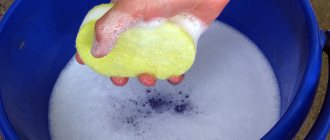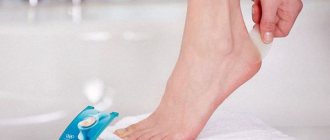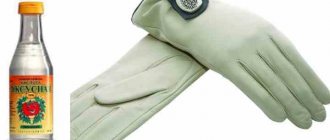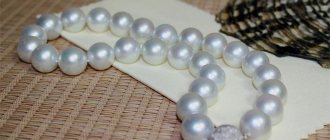To effectively care for leather shoes, you need professional products: cleaning foams and sponges “Divide”, “Master Shine”, nourishing cream Kiwi, Salton, salamander impregnation, Wax Erdal, cream dyes for leather Salton, Twist Fashion, CHIST. Home remedies: softness - Vaseline, glycerin, shine - ammonia alcohol, water protection - fish oil, linseed oil. Seasonal shoe care includes cleaning the inner surfaces and insoles in the summer, thorough drying in the winter, and additional protection with water-repellent agents in the spring and fall. Stains and odors can be removed using traditional methods using salt, talc, baking soda, vinegar, hydrogen peroxide, glycerin. Fabric or cardboard packaging is used for storage.
Proper care of leather shoes begins with their purchase; it includes a daily set of measures aimed at keeping them clean and dry, as well as protecting them from dirt and moisture.
Primary processing of shoes after purchase
Caring for new shoes after purchase consists of:
- applying a hydrophobic agent;
- drying 12-15 hours;
- impregnation with protective cream.
Within 7-14 days after active wearing, the course of treatment is repeated.
Manufacturers recommend taking leather shoes home before going out for the first time to ensure they fit properly on your feet. If you bought a slightly shiny pair, lightly dampen the inside of the fabric with vinegar and leave it on the foot until dry. Thus, shoes or boots will be more acceptable in the shape of the owner's foot.
Advice! Before you wear the pair you just bought, leave them unpacked for 2-3 days. Leave the inside filling for writing the form (paper, cardboard, plastic dividers). The leather will regain its original shape and smoothness after being transported and stored in a shoe store.
If you have an unpleasant “chemical” smell, especially if you bought your shoes second-hand, air them out during the day or treat the inside with a cloth soaked in vinegar or hydrogen peroxide.
How to properly store boots with high tops?
In this case, you need not only to choose the optimal place to store boots, but also to organize everything correctly. Only in this case, capricious products will not be covered with creases, folds, and abrasions.
The following recommendations can be taken into account:
- An old but effective option with newspapers. Just don’t just stuff the paper into your boots; it’s better to roll it into voluminous fist-sized balls. They will help maintain the shape of the products, absorb all excess moisture, and will not stretch the material. If possible, it is recommended to update the filler every 3-4 months, monitoring the condition of the shoes.
Advice: Don't expect that the cardboard inserts that accompanied the boots when they were sold will keep the product in shape during the summer months. After just one season of active wear, the models will noticeably stretch and these inserts will simply sink into them, not fulfilling their purpose. Therefore, you need to take care in advance about selecting a suitable option.
- If there is enough space in one of the closets, then it is better to hang your favorite pairs of boots using specialized store-bought or homemade hangers. A plastic part resembling a mannequin's leg is inserted into the boot, which is fastened. And the hook clings to any crossbar.
- As a last resort, you can also use trouser hangers, which consist of two wooden bars that clamp the upper part of the product. To prevent dents from forming on the surface of the boots, you need to place strips of thin foam rubber or fabric under the crossbars.
- Finally, inflatable and plastic fillers provide the desired degree of fixation of the boot. True, there are several negative aspects to their use. Plastic has a specific odor that is transmitted to leather and suede. Some people don’t even notice this, and some then cannot wear such boots. Inflatable elements begin to deflate after some time, so they need to be replaced or inflated. And if something heavy falls on such fillers, they can burst with a fairly loud sound.
It turns out that the main thing when storing high boots is to prevent creases. Under no circumstances should you simply fold your boots by bending the top and put them in a box. Even natural leather, so impervious to external influences, will not be able to retain its original texture with this approach.
We recommend: Where is the best place to store potatoes if there is no cellar?
Products for the care of shoes made of genuine leather
Leather products must be treated with store-bought or inexpensive home care products to maintain their appearance, warmth, and water-repellent properties.
Professional shoe cleaning products
A number of products will help you care for shoes made of genuine leather, including waterproof nourishing creams, color-restoring dyes and sponge impregnations.
Table 1. Shoe care products
| Name | Volume | price, rub. |
| Daily care | ||
| "Dividik" foam cleaner | 125 ml | 110 |
| "Master shine" sponge | 1 PC. | 31 |
| Salton sponge with dispenser | 1 PC. | 135 |
| Salamander | 1 PC. | 120 |
| Nutritious cream | ||
| Kiwi | 50 ml | 69 |
| "Master Shine" | 50 ml | 15 |
| Salton | 50 ml | 53 |
| Salamander | 75 ml | 115 |
| Water-repellent impregnation | ||
| Spray Silver | 250 ml | 180 |
| Salamander | 300 ml | 299 |
| Erdal wax | 75 ml | 133 |
| Leather paint | ||
| Silver | 75 ml | 92 |
| Salton | 250 ml | 249 |
| Twist Fashion | 250 ml | 243 |
| Cream paint CHIST | 60 ml | 47 |
The product range is available in different versions, depending on the type and color of the material.
It’s also worth getting brushes, sponges and wipes for proper care.
Traditional methods of caring for leather shoes
Home remedies can replace shoe care or store-bought shoe care products.
Protect from drying out
Castor oil or any other vegetable oil will help restore the softness of dry leather shoes. Wipe, dry and polish with a soft cloth.
Suitable for shoes and nourishing cosmetics for hands, body, face, baby cream. Just put them on the surface and rub them in, let them in.
Regular Vaseline or glycerin will save the skin from cracking.
Bringing back the shine
To give your skin a glow, treat it with a solution of ammonia (1/2 teaspoon per glass of water). Dampen the cloth, thoroughly wipe the shoes, and perform final polishing with a rag. For better cleaning, add 1 tablespoon of liquid baby soap to the mixture.
Apply a foam of equal parts whipped milk, egg white and sugar and let dry. Remove any remaining foam with a flannel sponge.
Create a water-repellent barrier
To protect against moisture, prepare a solution of fish oil, turpentine and wax (20: 2: 5) in a water bath. Pour the mixture over the product and let it dry.
Lard (unsalted), fish oil and flaxseed oil are water resistant. Rub into any center, carefully working the seams.
Important: do not apply several layers of different products (home or professional) at the same time. Leather for shoes should “breathe”.
Subtleties of seasonal shoe care
To extend the life of your shoes, care for them at home every day, depending on the season and weather conditions.
Summer shoe care
A special feature of caring for summer models is the need to clean the outer and inner surfaces of sandals and insoles, where road dust easily penetrates.
In summer, clean your shoes with soapy water.
Clean the outside with a cloth soaked in soapy water. Wipe lightly soiled insoles with a damp, antibacterial cloth. Wipe very dirty pads with traces of dust with a cotton pad soaked in hydrogen peroxide.
Summer suede models require careful cleaning of dust with a special rubberized brush and subsequent treatment with a protective spray. Do not let the material get wet.
Patent leather sandals do not wear quickly, wipe them with a damp sponge and carefully remove moisture with a flannel. To preserve the paintwork, rub in a couple of castor oils (glycerin or petroleum jelly) once a week.
Winter shoe care
Processing leather or suede models of winter boots involves thoroughly drying, impregnating and protecting the product:
- Immediately upon return, wipe the product with a dry cloth.
- If salt stains persist, remove them with soap and water.
- We take out the inserts and put them to dry.
- Periodically (twice a month) wash the insoles in a thick soap solution. Contact the retailer when purchasing insoles to find out if this procedure is possible. Typically, all insoles can be removed and gently washed by hand.
- If your shoes are wet, stuff them with old newspapers or use an electric dryer.
- The main thing is to not place shoes near the radiator; the leather dries out, cracks, and the sole and heel become deformed.
- Treat the product with nourishing cream to protect it from frost.
Important! Do not use shoe cosmetics containing silicone for winter care. The substance freezes at low temperatures and may damage skin.
Shoe care in the off-season (spring, autumn)
The main task is to protect against penetration and absorption of moisture.
Semi-seasonal care includes evening and morning treatment:
- Dirt should be removed immediately upon return without allowing it to dry.
- Lubricate the surface with shoe polish. Suitable dyes should be used for black and brown shoes. Colored shoes should be treated with colorless cream. For lacquered models we use sprays, oils and polishes, o.
- If your shoes get wet, let them dry until the morning and apply a hydrophobic agent 20 minutes before leaving the house.
Clean suede surfaces only when they are dry. Remove dirty fragments with a special brush or folk tools (thin paper, abrasive, nail file, eraser).
Advice: You should not wear suede shoes and boots during half the season. Moisture and dirt shorten their service life and spoil their appearance.
Preparation for storage
Before storing boots, they should be prepared, following certain rules that are common to all types of these boots, including wading and rubber.
It matters what type of material was used to make the shoes. Based on the characteristics of a particular item, it should be prepared for storage.
Boots of any kind must first be cleaned of contaminants (dust, dirt, reagents). In this case, all parts of the shoe should be treated, including the sole.
You cannot use too hard or metal brushes to clean boots: they leave scratches.
- Shoes made of suede and velor are treated with special wire brushes. In this case, the worn areas can be lightly rubbed with fine sandpaper, and then held over steam for several seconds. High suede boots - “over the knee boots” - can lose their appearance within one season. You need to correct the situation before sending them for storage, because it will be much more difficult to do this later.
Before storing suede boots, wipe them with a weak solution of vinegar and dry them well. This simple procedure will return them to their attractive appearance.
- Storing rubber boots with high tops, also called wading boots, as well as other shoes that have been worn for a very long time, should occur after preliminary disinfection. Traces of sweat inevitably appear when wearing shoes of this type for a long time. Disinfection can be done using a weak (pink) solution of potassium permanganate. It is applied to a cotton pad and treated with it all the internal surfaces of the shoes.
- Canvas boots should also be stored after they have been disinfected . You can also cope with the unpleasant odor inside shoes using hydrogen peroxide (3%).
Storage organization
After processing, the items are dried well. This should be done in natural conditions, in places with good ventilation. Artificial heat sources should not be used to dry shoes. This could end sadly. Rubber boots can lose their tightness, and natural leather becomes too hard and loses its elasticity.
Before storing high boots, crumpled paper is tightly stuffed into each of them, and then they are fastened with a “snake”.
Boots must be stored in a cardboard box, the dimensions of which will correspond to the height of the tops. forbidden to use polyethylene bags or plastic containers with sealed lids for this purpose .
Before storing shoes in a closet, it doesn’t hurt to put some kind of moth repellent in each box. First of all, this applies to boots that have natural fur inside.
Cleaning genuine leather from various stains
When you decide to treat stains, use household chemicals or improvised means.
Salt stains
Professional cleaning products, foams, and impregnations from the Salton, Silver, and Divideek series will help protect and clean winter shoes from traces of salt and reagents.
Effective folk methods:
- Using a solution of 3 tablespoons of vinegar essence and 1 tablespoon of water, remove the white stripes and dry.
- A cotton pad soaked in alcohol, vodka or ammonia wipes the skin. After drying, rub into nourishing cream.
- Soft paper towels wrapped around wet shoes will absorb the water along with any traces of salt.
Street dirt
Leather goods dust is wiped off with a cloth soaked in a solution of washing soap. Clean seams, folds and laces with a toothbrush.
The water for washing should be cool; hot water will stretch the leather, deforming the product.
Do not use abrasive materials or hard sponges for cleaning.
Grease, oil stains
Sprinkle greasy strips with starch, baking soda, talcum powder, and crushed chalk. Leave for 1-3 hours. Shake, wipe with a damp cloth.
Rub half of the fresh onion over the fat splash. The stain should disappear.
Wipe the stain with a solution of baking soda (1 teaspoon per tablespoon of water). Leave for half an hour, wipe with a damp cloth.
Black stripes
Black streaks on white shoes can be erased with a pencil eraser or rubbed off with toothpaste.
A paste of baking soda will help remove black spots. Apply to prints, rub in and remove with soft flannel or cloth.
Scratches
Soften scratches with leather paint to make them less noticeable.
As an express tool, you can use a simple felt-tip pen or marker, matched to the color of your shoes.
Treat small scratches with a cotton swab dipped in olive oil. After drying, the marks will disappear.
Original solutions
Designers offer many interesting ideas to solve such a problem as storing shoes. Here are some of them:
- a closet with glass doors, where boots and shoes are not laid out in containers or boxes, but are displayed, as in a display case, which helps to quickly select the right pair;
- storage located under a bed or sofa in a drawer, tray or organizer;
- hangers on which shoes are hung on a hook or secured with a clip;
- ottomans, banquettes, sofas, equipped with a shoe storage system inside;
- a metal grid attached to the wall, from which shoes are hung by the heels;
- hooks for outerwear, nailed to the wall of the hallway, dressing room in a checkerboard or other order;
- hanging pockets made of transparent film located on the inside of the cabinet door for storing low-heeled shoes, ballet shoes, slippers;
- wicker baskets or bright buckets placed on shelves, preferably closed;
- retractable systems for storing trousers, where boots and shoes are hung using small hangers and clothespins;
- a cornice or molding attached to the walls of the dressing room, serving as a place to store shoes and sandals;
- PVC pipes with a diameter of 10-15 centimeters, glued to the back wall of the rack or shelf and interconnected;
- a tray filled with gravel and placed at the threshold where dirty shoes are placed;
- drawers equipped in the steps of the stairs.
Removing odors from shoes
To eliminate unpleasant odors, suitable storage products are: aromatic sachets, special deodorants, ionizers or available home remedies.
Foot odor
To eliminate sweat odor, you can use:
- Vinegar, hydrogen peroxide, ammonia, manganese. Soak the cotton wool and treat the inner surface.
- Talc, baking soda, salt, crushed activated carbon. Pour into shoes, leave for 2-3 hours, shake.
- Additionally, you can wipe with peroxide, green tea, lemon balm or mint infusion. Moisten the napkin, wipe it, dry thoroughly.
Cat marks
Traces left by an animal should be removed immediately after its appearance, without allowing it to be absorbed:
- Stuff shoes with dry wipes and paper.
- after absorption, remove the rags,
- wipe the surface with vinegar.
- Sprinkle with baking soda and leave for another half hour.
- rinse with peroxide and dry.
Mold
Salt, baking soda or charcoal in shoes will eliminate the smell of dampness and mold. Carefully distribute the powder inside, put the shoes in a plastic bag for 12 hours, shake.
First eliminate the cause of mold: wipe the inner surface with “Belize” manganese solution and vinegar.
Storage options
You can always arrange a place in your apartment or house where it will be convenient to store your shoes.
Hallway
The most common option is to store shoes in the hallway. Here are footwear items that are often used or may be needed when the weather changes:
- Boots and boots designed for rainy weather should always be at hand, so they can be placed in a shoe rack with a pull-out shelf.
- Slippers are also placed at the front door, using special holders in the shoe rack for storing them or allocating a separate section in the closet.
- Sports shoes, roller skates, and skates are stored in the same way.
- Shoes that are worn at certain times of the year should be placed in the hallway, in a closet with not standard, but pull-out shelves, divided into compartments for high boots and low shoes. An alternative could be a niche equipped with a storage system for pairs of shoes.
- Convenient racks for storing shoes that are often used.
Wardrobes in other rooms
Having arranged your shoes for everyday wear, you should think about the methods and place of storing seasonal, weekend, and special shoes.
Family members organize these items in their closet, placing shoes or boots under matching outfits and seasonal footwear items on the bottom or top shelf. It is convenient to put shoes in transparent boxes with sticker labels indicating which pair is there. If the boxes are opaque, then you can glue a photo of the shoes to the lid.
The best way to store shoes in a closet would be multi-section organizers with a transparent zippered lid that provides an overview of the contents.
Boxes made of polypropylene that do not emit odors, equipped with holes for ventilation, are also suitable.
Wardrobe
The space for storing shoes in a small dressing room, for example, converted from a closet, is organized using racks of different shapes. Soft hanging ones are suitable for ballet shoes, sneakers, mules, loafers, slip-ons, and round ones will save space and allow you to arrange your shoes compactly, without boxes, which will help you quickly find the right pair.
Placing shoes at an angle, as well as vertically, makes the choice easier, but if it is an open section in the dressing room, then dust gets on the shoes.
A good option is a hanging organizer with spacious pockets that is placed on the door.
Author:
Zakharova Nina Afanasyevna
I hope you like my article! If you find any shortcomings, just write to me about it! I am always ready for a conversation and will answer any questions you have, ask them!


